Abstract
As a sustainable and holistic approach to agriculture, agroecology has received considerable attention in recent years because of its potential to address the environmental, economic, and social challenges of agricultural systems. In order to identify key trends, influential authors, impactful journals, and emerging research themes surrounding the agroecological adoption topic, we performed a bibliometric analysis based on metadata from documents dealing with the topic and methods employed for its assessment over the period of January 1990 to July 2023, extracted from the Web of Science database. Based on the metadata of more than 1280 articles, our analyses show that the “identification of agroecology adoption determinants” and the “development of knowledge for food sovereignty” are among the trendiest research topics, while farming systems management and biodiversity issues are basic themes. The issue of analyzing agricultural productivity is more often linked to the impact of climate change. Also, we find that machine learning methods are not yet widely used to model the process of farm agroecological adoption. The contribution of African countries to the topic remains marginal in terms of documents produced, despite the predominance of traditional agriculture on the continent.
Keywords:
agroecology; transition; metadata; farms; bibliometric method; machine learning; African countries 1. Introduction
A paradigm shift in agricultural production systems is urgently required for our planet. Due to the numerous negative effects induced by the extensive use of chemical treatments, the conventional production system from the 1950s, which is still in use in many countries, has reached its limits [1,2,3,4]. Nowadays, the question of how to satisfy the needs of the present without compromising the capacity of future generations to satisfy their own needs is one that is currently being asked by a large number of researchers and international organizations. Several alternative production systems exist in the literature [5,6] and agroecology is identified as one of the most promising alternatives [7,8,9,10].
In this paper, we use Dalgaard’s [11] definition that agroecology is “the study of the interactions between plants, animals, humans, and the environment within agricultural systems”. Some authors state that there is no unique, recognized definition of agroecology [7,11,12,13,14]. However, most researchers acknowledge agroecology as a discipline of integration but define it in other terms, for example, as “the application of ecological science to design and manage sustainable agroecosystems” [15]. More broadly, we note that agroecology incorporates ideas about a more environmentally and socially sensitive approach to agriculture, one that focuses not only on production but also on the ecological sustainability of the production system, which implies a number of features on society and production that go far beyond the boundaries of the agricultural domain [16].
The issue of agroecological transition emerged to address the need for adaptation for all of the world’s agriculture to meet social demands, environmental challenges, climate disruption [17] (p. 335), and the gap between the scale at which most agroecological information is currently produced and the scale at which most decisions about farming systems are made [9].
Agroecological transition can be defined as “the set of linked technical and organizational processes by which new production modes based on agroecological principles gradually and sustainably replace systems resulting from conventional intensification that have led to the massive use of synthetic inputs, or allow very low productivity farmers to intensify their production without reproducing this conventional intensification scheme”. In either case, the objective is to develop an agriculture that can sustainably ensure both local and global food security across all relevant dimensions [17] (p. 337).
However, this transition remains a major challenge in different regions of the world, and in particular in West Africa [18,19]. This article’s goal is to analyze the agroecological adoption field so that readers will have a better understanding of the current state of the field’s research as well as some methods for its evaluation. We specifically look at how the various agroecological adoption sub-themes have been studied in terms of research development to date. We list some of the key players (countries, journals, authors, etc.) who have influenced the field’s growth. Before introducing some methodological approaches for assessing agroecological adoption, a quick review of Africa’s agricultural system is suggested.
To accomplish these goals, we will conduct a bibliometric analysis of the literature on agroecological adoption to identify the keywords, authors, organizations, and nations pertinent to the study subject.
2. Materials and Methods
The data used in this paper cover the period from January 1990 to July 2023. They were taken from the Web of Science database and primarily concern research articles, as well as other kinds of documents such as book chapters and reviews. To achieve this, the terms “AND” and “OR” were used in an advanced topic search, and the following search strategy was developed: TS = ((agroecolog* OR agro-ecolog*) AND (transition OR scaling up OR adoption or intensification OR extension) AND (method* OR machine learning OR artificial intelligence OR data science OR statistic* OR model* OR econometric OR multi-criteria OR multi-attribu*)), where TS denotes the TOPIC search field under WoS and the asterisk any character(s) that can be inserted after the corresponding word(s) and still have a meaning, such as “agroecology” or “agroecological”. Bibliographic metadata for 1286 documents was gathered, including details on the authors, the journals in which the documents were published, the nations where they were published, and more. The documents covered 115 nations, 4951 authors, and 470 journals. In accordance with WoS’s restriction of 0–500 entries per export for full information extraction, the metadata was exported in multiple files in BibTex format. Before conducting the analyses, the various file fragments were combined into a single file. The main packages, such as bibliometrix and bibliometrixdata with their dependencies, were used to create the indicators using R software [20].
Descriptive analysis, network extraction, and visualization are all parts of metadata analysis [20,21]. It initially involved highlighting key trends, influential authors, impactful journals, emerging research themes, and so on, by the level of analysis using metrics like most relevant entities, most cited entities, major countries or organizations to which the authors belong, the relative contribution of journals to the advancement of the subject (Bradford’s Law), h-index, the frequency of publications by field or theme (Lotka’s Law), and so on.
Bradford’s law describes the distribution of citations for a particular topic or field and can be used to determine which reviews have been most frequently cited in that field or topic of research [22]. Bradford stated that for a given study field, the top third of journals (zone 1 or core) represent the journals that are most frequently cited in the literature on that subject and are therefore likely to be of greatest interest to researchers in the discipline. Journals with an average number of citations are found in the middle third (zone 2), while those with fewer citations or those marginally relevant to the topic are found in the bottom third (zone 3 or tail). H-index is an author influence metric that can also be applied to assess the influence of a journal or a country on a specific field [23]. The h-index of a journal represents the highest number h of its publications that have received at least h citations each. Its purpose is to quantify the scientific productivity and impact of the units compared according to the level of citations of their publications. According to Hirsch [24], who designed the h-index, this index makes it possible to gauge the relative importance, relevance, and overall impact of all previous research contributions. This indicator has received a lot of criticism because it ignores the nature of citations—whether they are positive or negative—and undervalues the impact of journals with few publications that receive a lot of citations, among other things. Lotka’s law describes the frequency of publication of authors by postulating that the greater the number of publications, the fewer the number of authors who can publish as many articles [25].
Then, using methods like science mapping and performance analysis [26,27], we highlighted the trends of the various research structures that frame the term “agroecological transition”. All the analysis and indicators used in this article and the corresponding metrics were carried out following the recommendations prescribed in documents that provide an in-depth description of the main steps to be followed for carrying out bibliometric analyses by Aria and Cuccurullo [20]. In order to achieve the objectives pursued through this study, the following research questions will be addressed:
Q1: What are the main entities (authors, journals, and countries) contributing to the progress of research on agroecology adoption and methods for its assessment?
Q2: What are the trendiest themes related to this topic?
Q3: To what extent have machine learning methods been adopted in the modeling of agroecological transitions compared with other methods?
3. Results
This section is subdivided into six (06) sub-sections presenting the main entities of the study, the most trending themes, and an outline of a methodological approach for modeling the adoption of agroecology.
3.1. Publication Trends and Journal Landscape
Since 1990, there has been an increasing number of publications on agroecological adoption and its methods. In contrast to the period 1990–2000, when fewer than 10 articles were produced annually, since 2015 we are currently seeing a high number of productions of more than 50 documents annually. The agroecological transition is becoming more and more important when discussing the broad agroecology study field. Agroecology adoption on a large scale is being sought after by researchers and farmers in various nations. The number of publications on agroecological transition over time is depicted in Figure 1.
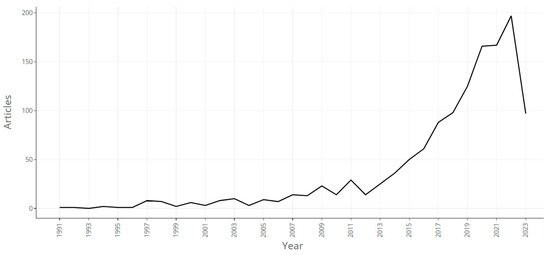
Figure 1.
Number of publications on agroecological adoption per year from 1990 to 2023.
The most significant sources in the literature were determined using both Bradford’s Law and the H-index approach. The number of journals (470) used for publications indicates that there are many options to publish articles related to agroecological adoption or methods to achieve this. Regarding journal performances, the decomposition provided by Bradford’s law results in a core group of 16 journals (i.e., a group of journals with high added value on the research topic, cluster 1) with 435 publications. For clusters 2 and 3, 427 and 424 articles were published, respectively, and consisted of 88 and 366 journals, respectively. The sixteen (16) publication sources that make up the core group are shown in Figure 2. Six (06) of them stand out among the rest, with more than 30 publications each. These journals cover topics like food security, ecosystem and land management, agricultural economics, and sustainability. Except for “Agronomy for Sustainable Development,” which is from North America, the majority of them are Western European journals.
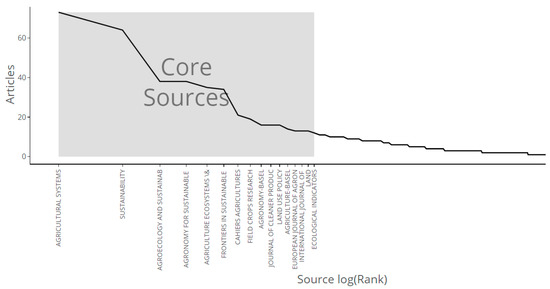
Figure 2.
Distribution of the core group’s journals using Bradford’s law from 1990 to 2023.
At some levels, the rank according to the h index (Figure 3) shows a different hierarchy from that obtained using Bradford’s law. However, four of the top five sources identified by the Bradford law are also those with the highest h index. Agricultural System remains the top-ranked journal with an index of 23.
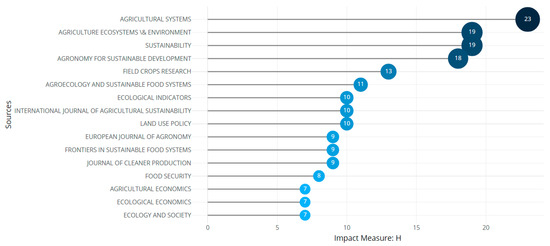
Figure 3.
Distribution of the 16 most important publications, according to the h-index, from 1990 to 2023.
3.2. Top Authors and Affiliations
The analysis of the authors’ citation performance was based on the guidelines prescribed by Lotka’s law. As a result, three different categories of authors can be defined: occasional authors (those with a single publication during the study period), authors in the intermediate group (those with between two and four publications during the study period), and influential authors, or the core group (those with at least five publications during the study period). Figure 4 shows that Theron O is one of the authors who has published the greatest number of articles (14) on agroecological practices adoption, and some of the related methods over the study period. He is followed by Tittonell P, Tello E, and Duru M with 11 and 10 publications, respectively. Theron’s key research has focused on the evaluation and modeling of the agroecological transition at the territorial or local level [28,29,30], while the main work carried out by Tittonell has focused on establishing typologies and identifying levers for the agroecological transition of farms [31,32,33,34]. Tello and Duru’s main studies focus on land use and issues related to methodology for designing agroecology transitions and their application at the territorial or local level [35,36,37,38,39]. Core groups make up no more than 5% of the total authors, while occasional authors account for 88% of the total. Figure 4 lists the 10 most influential authors of the series according to Lotka’s law.
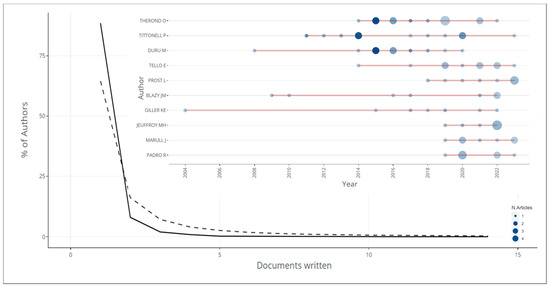
Figure 4.
The 10 authors with the highest number of articles through Lotka’s law, from 1990 to 2023.
Regarding the institutional affiliations of the various authors of the study articles, a total of 1796 affiliations were identified. Over 85% of these institutions published fewer than 5 articles, while less than 2% of institutions each published more than 20 publications over the study period. The top twenty institutions are listed in Figure 5. With 110, 69, and 56 publications, respectively, Montpellier and Toulouse Universities in France and Wageningen University in the Netherlands top the list. Some African universities, such as Addis Ababa University and Haramaya University in Ethiopia, the University of Sokoine in Tanzania, the University of Abomey-Calavi in Benin, and the University of Ghana, are among the top institutions with an average number of publications of around 23.
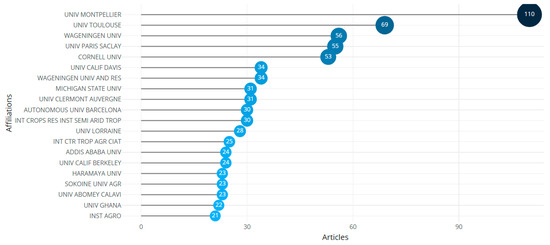
Figure 5.
Distribution of the top 20 institutions from 1990 to 2023 according to publication number.
3.3. Most Cited Documents in the Literature
In this section, we consider articles with more than 200 citations overall. Therefore, we have identified 16 articles among the 1286 documents studied. With 512 citations, the most cited article in our collection addresses the issue of the determinants of farmers’ choice of adaptation methods to climate change in the Nile Basin in Ethiopia using an econometric approach and is written by Deressa et al. [40]. It is followed by Perfecto and Vandermeer’s [41] study on the agroecological matrix as an alternative to the land-sparing/agriculture intensification model, which has 418 citations. An overview of the most frequently cited papers is shown in Figure 6. On this graph, the importance of the number of citations for a given document is indicated by the size of the circle around its author. By cross-referencing the most cited articles with authors with a high number of published articles, only an article by Tittonell [42] entitled “Ecological Intensification of Agriculture—Sustainable by Nature”, with 378 citations, and an article written by Duru et Theron [39] entitled “Designing Agroecological Transitions: A Review”, with 337 citations, could be identified, indicating that only these works belong to these two categories.
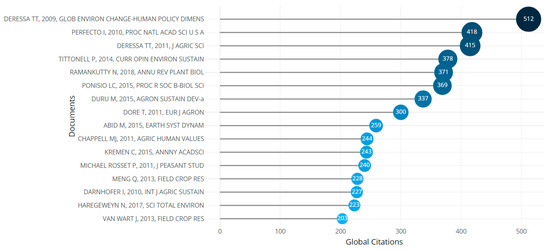
Figure 6.
An illustration of works from 1990 to 2023 that have received at least 200 citations [39,40,41,42,43,44,45,46,47,48,49,50,51,52,53,54].
3.4. Countries Production
Corresponding author’s countries highlight the production of authors affiliated with each country of the study. From January 1990 to July 2023, 20 out of the 115 countries covered by this study produced about 80% of the publications on the subject. With 217 and 165 articles, respectively, France and the United States have the highest number of articles produced on the topic (Figure 7). With an average of fewer than 50 publications, only five (05) African countries (English-speaking countries) are in the top 20. This suggests that the English language deficit is a factor that affects how well-known African countries’ productions are in the area of agroecological transition. The abbreviations SCP and MCP stand, respectively, for “single country publications” and “multiple country publications”. The least number of papers with co-authors are published in Brazil and Nigeria, while multi-author collaborations are most common in Kenya and China. Despite their large number of publications, the collaborations made by French and American authors with others remain weak. The overall scientific production of African countries is 16% and remains low, despite the predominance of traditional agriculture in these countries. The sustainability of traditional farming systems and their potential as a basis for agroecological transition are well known [16,55,56]. However, scientific production in African countries regarding agricultural issues suffers from the unavailability of timely data [57,58,59].
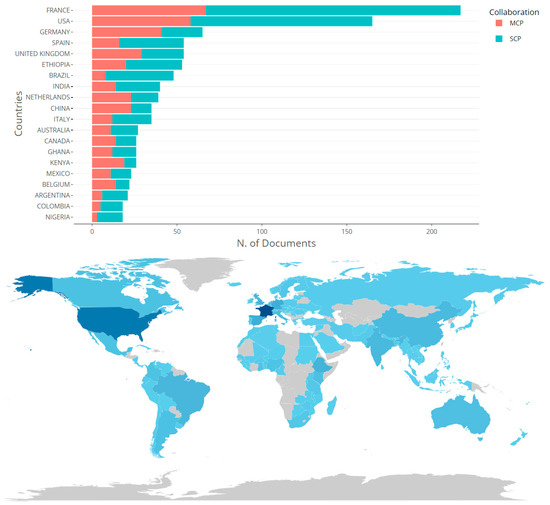
Figure 7.
Number of documents published by the 20 most influential countries from 1990 to 2023.
Looking specifically at the issue of agroecological adoption, a lack of institutional frameworks to promote agroecological practices has been noted in some West African nations, and agroecology is primarily driven by farmer organizations and non-governmental organizations [17,60,61,62]. Also, the majority of agricultural policies in African nations continue to support initiatives for intensification that are based on 1950s green revolution techniques [60,62] and the conclusions of the 2006 African summit on fertilizers. However, with the adoption of new agroecology programs in recent years, such as the “program to support agroecological transition” (PATAE) in some West African countries such as Burkina Faso and Mali [62], the Great Green Wall [63], the “dynamic for agroecological transition in Senegal” (DyTAES) [64], etc., and the action of a large number of NGOs, the issue of agroecology is gaining in importance in African countries.
3.5. Keywords Analysis
3.5.1. Trend Topics and Co-Occurrence Analysis
The result of the co-word analysis [65], using Biblioshiny [20], based on keyword co-occurrence, gives the different methodological approaches that are used to promote agroecology adoption and the main themes/issues studied in this context. Figure 8 shows trend topics, and apart from the keywords related to agricultural systems management with a frequency usually reaching 150, the trendiest keywords are models, technology, classification, challenges, preferences, simulation, and the overall methodological framework with frequencies usually between 50 and 100. The issues of avoiding deforestation, the use of technology, and assessing the consequences of the agricultural system are among the topics that have been studied consistently over the years.
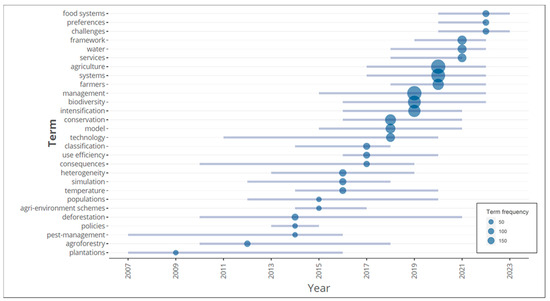
Figure 8.
Most trendy keywords and topics.
Figure 9 shows the links between the different keywords used in the selected articles and to what extent they constitute major research groups. As a result, words like Africa, determinants, adoption technology, adaptation, tillage, and strategies can be found in the first class (shown in blue in the figure). Consequently, relevant research areas in Africa include the investigation of the factors influencing the adoption of agroecology, the development of farmer knowledge, or the adoption of technologies to increase the performance of African agricultural systems. Additionally, words like management, models, systems, food security, productivity, climate change, and impacts can be found in the second class in red. Thus, the analysis of the productivity of various agricultural systems, the assessment of the impacts of climate change on agriculture, and how to model growth in agricultural production. The final class (shown in green and violet) consists of terms like sustainability, innovation, networks, food sovereignty, innovation, biodiversity, ecosystem services, and intensification. The key concepts in these classes focus on examining the link between agroecology and sustainability (or food sovereignty), finding ways to conserve biodiversity while seeking to intensify agricultural production, or developing the appropriate network or innovations to enable sustainable production.
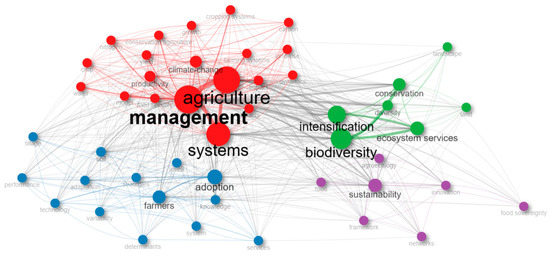
Figure 9.
Keywords co-occurrence network related to “agroecology adoption”.
3.5.2. Themes Relevance and Degree of Development Resulting from Keywords Clustering
Using clustering algorithms provided by the bibliometrix package, we were able to link the various themes based on selected article keywords. This clustering resulted in five primary thematic classes covering: global agriculture, adoption of agroecology, climate change, management of agricultural landscapes, and the development of farmers’ knowledge.
When the degree of development of the themes (RankDensity) and their degree of relevance (RankCentrality) are crossed, “adoption”, “climate change”, and “knowledge development” are the themes that come out on top (Figure 10). The significance of the keywords mentioned in Section 3.5.1 is consistent with these various classes. While topics such as farming systems management, agricultural intensification, and biodiversity management have long been addressed in the past, those relating to the study of strategies and determinants of the adoption of agroecology, the development of knowledge and innovations for food sovereignty, and the study of the impact of climate change on farm productivity still need to be explored in depth.
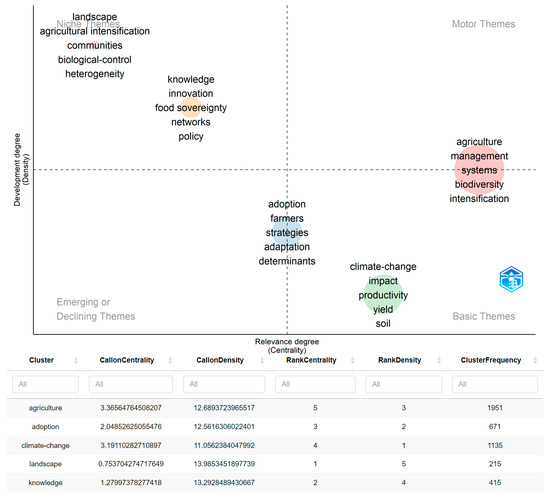
Figure 10.
Main thematic classes resulting from the clustering of keywords.
3.6. Research Gaps: Methodology for Agroecological Transition Modeling
Although questions relating to the identification of the determinants and strategies of agroecological adoption are omnipresent in the literature, research with a view to developing robust and comparable methods to achieve this from one geographical area to another has yet to be carried out. For instance, keyword analysis revealed that machine learning methods and econometric ones are not widely used to model the process of farm agroecological adoption. Most methodological studies have focused on developing a framework for evaluating the process of adopting agroecology using indicators or a multi-criteria approach [2,8,66,67].
Agroecological transition can occur at any scale (plots, fields, farms, nations, etc.). However, analyzing this transition at the country scale can be more complex than at a plot scale, and the transition from one scale to another is not always obvious [11]. The spatial dimension, or scale at which agroecology is to be adopted, must be clearly defined as part of the analysis of the agroecological transition. Plot scale, farm scale, and territorial scale, such as the country or region, can be distinguished as the three main scales [2,8,19]. To date, the farm transition has not received much attention as a research topic [68,69]. Transition is generally studied at the scale of the territory or landscape, as shown in the keyword analysis section. Thus, despite the fact that the farm is the core of the agricultural production system, only a small number of studies concentrate on this level [70]. Additionally, a time dimension must be included in the transition analysis to enable performance comparison and horizon forecasting [71]. The results will be even more significant if the time dimension is taken into account when comparing the economic performance of agroecological farms with that of other production systems, such as the conventional system. In fact, the adoption time increases with increasing spatial dimensions. Therefore, in order to plan the technical and financial resources required to achieve the desired results in a timely manner and use a method that is appropriate, modeling work will need to take into account the correlation between time and space. In different regions of the world, it is still difficult to model the process of adopting agroecology on a large scale [68,69]. There is some work that needs to be completed in advance to accomplish such analyses. In fact, three main steps can be easily identified regardless of the modeling approach one chooses to use. First, a preliminary characterization of the farms is necessary in order to establish a typology or classification of these farms. Following that, a comparative analysis of the socio-economic and environmental performance of the various classes of farms is required based on the typology that will be obtained [2,7,14,29]. Modeling the adoption process for non-agroecological farms is one of the last steps based on the main characteristics of the classes identified previously, and this modeling should make it possible to highlight the key variables that affect farmers’ decisions as well as the opportunity costs. According to the general framework of the theory of the “diffusion of innovation” [72], when faced with an innovation, there is initially a small number of adopters (early adopters, and innovators who are keen to try new things and take risks). The second phase, known as the growth phase, is when the majority of the population and the waiters decide to adopt the innovation. During this phase, the number of adopters increases and reaches a maximum. The refractory decides to adopt the innovation during the final phase. The adoption function would take the shape of an ‘S’, characteristic of the logistic function in this configuration. Agroecological practices can be viewed as innovations that directly involve stakeholders in the innovation process while mobilizing a variety of local knowledge sources and the most cutting-edge scientific knowledge to optimize farm production [73]. Acceptance of innovations remains a complex and multidimensional notion influenced by several variables. Farmers’ decisions are explained by the goals they pursue and the resources available [74]. Farmers consider the possible effects of their adoption decisions on the social, economic, and organizational activities of their farms and families, in addition to the characteristics of their agroecosystems. It is, therefore, necessary to provide clear information based on empirical analysis that can assure farmers that the practices they will adopt will meet both short-term (food and income generation) and long-term (soil fertility improvement) objectives [75]. In this regard, econometric methods may prove useful for simulating the adoption of agroecology and its scaling up. These models enable the description of the factors that affect farms’ economic and environmental performance in order to broadly predict their variations. The relevance and realism of these models are increased by taking into account multiple objectives that influence farmers’ decisions in addition to the goal of income maximization [76]. However, the challenge of using econometric models lies in accounting for causal effects. More broadly, automatic learning models can be used through the multiple algorithms they provide, such as multiple logistic regression (LRM), ensemble methods (decision trees), and non-parametric methods (naïve Bayes, k nearest neighbors), to learn from features and make efficient modeling [77,78,79,80] For instance, Côte et al. [17] (p. 230) state that, prior to 2019, there had not been a thorough and systematic evaluation of the sustainability of agroecology in comparison to conventional agriculture that would have a broad scope. According to these authors, the biggest challenge in conducting such an evaluation is coming to an agreement on how to categorize farms into agroecology and “conventional” agriculture among the practices that can be seen today in sufficiently diverse environments all over the world. For our part, it might be possible to create a reliable typology based on a quantitative approach using automatic classification models provided by machine learning methods. Econometric approaches can be used to quantify the short- and long-term effects and opportunity costs for farms wishing to move from one class to another. More generally, we believe that it is necessary to develop harmonized approaches to modeling the agroecological transition and that artificial intelligence methods can be used to this end.
4. Discussion
The agroecological transition issue’s significance is growing over time. Indeed, the rise in the number of publications on the topic attests to its significance and can be interpreted as a sign that it is reaching a certain stage of development. Additionally, the inclusion of agroecology in the research domains of international organizations, such as the Food and Agriculture Organization of the United Nations (FAO), demonstrates that its status as a significant scientific and research field is expanding significantly [81].
The walktrap clustering algorithm was used to group keywords into five main thematic classes: agriculture, landscape, adoption, climate change and knowledge. Apart from the question related to agriculture and biodiversity management, other studies, such as [12,82,83], had not previously identified climate change, knowledge development, and adoption as research fronts. Adoption, knowledge development, and climate change are some of the trendiest issues and are identified as central issues in this study. Although the importance of the themes varies from period to period, some of them, such as those dealing with the management of agricultural landscapes or biodiversity, have remained constant over time. Given the topicality of climate change issues, in the process of modeling the adoption of agroecology, it would be interesting to quantify the role of agroecological practices in mitigating the effects of climate change.
The analysis of the present study also allows for the identification of the contribution of specific African nations and academic institutions to the development of agroecological transition research. In the African context, some authors argue that agricultural practices are less centered on the conventional production system than those in Western nations. Despite the considerable attention given to chemical products since the 2000s, these authors contend that overall use rates on the continent are still lower than in Western nations. However, ecological intensification is required in order to feed the expanding African population because “traditional” practices are still unable to do so [17] (p. 191). Much remains to be completed toward large-scale agroecological transformation in these countries, and current and future progress should be documented.
Compared to the findings of Wezel and Soldat [12], the order of the country’s importance has changed. In fact, France, which ranked third in 2009 in terms of the number of documents produced behind the US and the UK, now holds the top spot. Also, on the African side, contrary to the period before 2010, Ethiopia now appears in front of Kenya, which also appears in front of Nigeria.
Research in agroecology has remained self-reflexive in that it has focused a lot on how it is defined and what it is evolving into [82]. This suggests that additional empirical research will be required to offer a quantifiable analysis of the advantages of agroecology adoption. Our argument in Section 3.6 is part of this framework.
Some of the conclusions of the present study were also obtained by Shah et al. [84], i.e., the centrality of the issue of “agroecology adoption” among the various themes identified and the rank and major contribution of the European institutions to the growth of the subject. However, in contrast to this study, whose main objective was to show the relationship between agroecology, food and water security, and climate change, our study aimed to identify the extent to which researchers use some specific methodological approaches for modeling the agroecology adoption process. This revealed, for example, that automatic learning methods are still poorly used and that their use needs to be further developed for greater precision and harmonization. This conclusion highlights one of the research perspectives previously identified by Sott et al. [85] on the need to explore the use of artificial intelligence methods in solving problems relating to agricultural system sustainability.
A bibliometric study carried out by Liu et al. [86] on the evolution of research related to agroecosystem services revealed that the importance of agroecology increased fourfold between 2012 and 2017, reflecting the link between these two themes. The analysis of keywords and the main areas of research identified as part of this study also highlighted the important link between these two themes. Thus, we can deduce that the relationship between these two themes is bidirectional in the sense that agroecological practices induce ecosystem services and, conversely, the search for an increase in ecosystem services promotes the adoption of agroecological practices.
Previous studies on the sustainability of agricultural systems discussed in this article have used VOSviewer [87], Bibexcel [88], CiteSpace [89], and SciMAT [90] for bibliometric analysis. The use of the R tool through the package Bibliometrix [20] offered us just as many possibilities in terms of analyses and indicators as these tools. One of the specificities of the R tool is that it also offers the possibility of writing its own command lines for extracting evaluation indicators, which is in line with the fact that it is a complete programming tool.
5. Limitations
At the end of this work, we want to note some limitations that could affect our results to some extent. In fact, like other bibliometric studies, one of the limitations of this study concerns the fact that the metadata was extracted from a single database, namely WoS. As a result, WoS-unaffected documents listed in databases like Scopus are excluded from our analysis. However, WoS is considered to be one of the databases with the oldest and most comprehensive records of citation indexes [91,92,93,94], and it is often recommended to focus on a single database as merging multiple databases can be complex and confusing [21]. Although WoS does not always index as many journals as Scopus does [95], a sufficient amount of high-quality literature, particularly in the case of the natural or medical sciences, can be reviewed using this database, and all the trends to be studied are adequately represented [91].
When including entities by level of analysis, some arbitrary decisions also had to be made in order to keep only the main entities. The aim was to provide a synthetic analysis. This attitude does not necessarily have an impact on the quality of the analysis, according to Skupin [96]. By choosing to only include the top 10 cited authors during our analysis, for example, we do not in any way skew the ranking of the top 5 or top 100 cited authors. We simply present one situation among many others, as synthetically as possible.
In addition to these points, we do not explain in depth the informatics or mathematical techniques of bibliometric analysis used for our analyses in this article. So, we simply use the methods that have been written about by other authors and cited in our work. Therefore, readers are encouraged to read these documents if they want more information on these quite well-documented and thorough methods.
6. Conclusions and Perspectives
One of the challenges facing current agricultural research is finding the best strategies for the sustainable transformation of current production systems. Agroecology is proving to be one of the most suitable alternatives to the problem. Although significant progress is being made around the world, large-scale adoption of agroecology is not yet being observed, and African states should document the wide range of traditional knowledge (linked to agroecology) practiced on the continent in order to promote its adoption. This study demonstrates that while farming systems management, agricultural intensification, and biodiversity management have long been addressed in the past, those relating to the study of strategies and determinants around the adoption of agroecology, the development of knowledge and innovations for food sovereignty, and the study of climate change impacts on farm productivity still need to be explored in depth. Furthermore, our research shows that there is no universal agreement on the best way to model the transition of farms to an agroecological system, as each stage of this process may require a specific methodological approach, and machine learning methods reputed for their robustness and objectivity are still unexploited. Comparisons between conventional and agroecological production systems, based on real and high data quality, could allow a real transition to take place in the world and Africa in particular. One of the limitations of performance evaluation is the inability to classify farms in a reliable and consensus-based manner. Using machine learning techniques (such as decision trees, naïve Bayesian classification, multinomial logistic regression, and more) will help to overcome this limitation and complete the other evaluation and modeling steps that are still closely related to classification. Finally, future research can cover other databases, such as Scopus, to make comparisons with the findings of the present study.
Author Contributions
T.N. contributed to conceptualization, methodology, software, validation, formal analysis, literature search, data curation, and writing—original draft preparation. E.C.E. and S.K.C. contributed to conceptualization, supervision, and writing—review and editing. All authors have read and agreed to the published version of the manuscript.
Funding
This research received no external funding.
Institutional Review Board Statement
Not applicable.
Informed Consent Statement
Not applicable.
Data Availability Statement
Not applicable.
Acknowledgments
The first author would like to thank C. D. Traore and O. Drabo, whose suggestions and comments helped to improve his argument. He also thanks the Partnership for Skills in Applied Sciences, Engineering, and Technology (PASET) through its Regional Scholarship and Innovation Fund (RSIF) for its multiform support.
Conflicts of Interest
The authors declare no conflict of interest.
References
- Evans, A.E.; Mateo-Sagasta, J.; Qadir, M.; Boelee, E.; Ippolito, A. Agricultural Water Pollution: Key Knowledge Gaps and Research Needs. Curr. Opin. Environ. Sustain. 2019, 36, 20–27. [Google Scholar] [CrossRef]
- Mottet, A.; Bicksler, A.; Lucantoni, D.; De Rosa, F.; Scherf, B.; Scopel, E.; López-Ridaura, S.; Gemmil-Herren, B.; Bezner Kerr, R.; Sourisseau, J.-M.; et al. Assessing Transitions to Sustainable Agricultural and Food Systems: A Tool for Agroecology Performance Evaluation (TAPE). Front. Sustain. Food Syst. 2020, 4. [Google Scholar] [CrossRef]
- Tilman, D.; Clark, M. Global Diets Link Environmental Sustainability and Human Health. Nature 2014, 515, 518–522. [Google Scholar] [CrossRef]
- Watson, R.; Baste, I.; Larigauderie, A.; Leadley, P.; Pascual, U.; Baptiste, B.; Demissew, S.; Dziba, L.; Erpul, G.; Fazel, A. Summary for Policymakers of the Global Assessment Report on Biodiversity and Ecosystem Services of the Intergovernmental Science-Policy Platform on Biodiversity and Ecosystem Services; IPBES Secretariat: Bonn, Germany, 2019; pp. 22–47. [Google Scholar]
- Fouilleux, E.; Loconto, A. Voluntary Standards, Certification, and Accreditation in the Global Organic Agriculture Field: A Tripartite Model of Techno-Politics. Agric. Hum. Values 2017, 34, 1–14. [Google Scholar] [CrossRef]
- Newell, P.; Taylor, O. Contested Landscapes: The Global Political Economy of Climate-Smart Agriculture. J. Peasant Stud. 2018, 45, 108–129. [Google Scholar] [CrossRef]
- Barrios, E.; Gemmill-Herren, B.; Bicksler, A.; Siliprandi, E.; Brathwaite, R.; Moller, S.; Batello, C.; Tittonell, P. The 10 Elements of Agroecology: Enabling Transitions towards Sustainable Agriculture and Food Systems through Visual Narratives. Ecosyst. People 2020, 16, 230–247. [Google Scholar] [CrossRef]
- FAO. TAPE—Outil pour l’évaluation de la performance de l’agroécologie—Version test: Processus de développement et guide d’application; FAO: Rome, Italy, 2021; ISBN 978-92-5-134405-7. [Google Scholar]
- HLPE. Agroecological and Other Innovative Approaches for Sustainable Agriculture and Food Systems That Enhance Food Security and Nutrition; High Level Panel of Experts on Food Security and Nutrition of the Committee on World Food Security: Rome, Italy, 2019. [Google Scholar]
- FAO. Rapport Final du Symposium International Sur l’agroécologie Pour la Sécurité Alimentaire et la Nutrition; FAO: Rome, Italy, 2014; ISBN 978-92-5-108696-4. [Google Scholar]
- Dalgaard, T.; Hutchings, N.J.; Porter, J.R. Agroecology, Scaling and Interdisciplinarity. Agric. Ecosyst. Environ. 2003, 100, 39–51. [Google Scholar] [CrossRef]
- Wezel, A.; Soldat, V. A Quantitative and Qualitative Historical Analysis of the Scientific Discipline of Agroecology. Int. J. Agric. Sustain. 2009, 7, 3–18. [Google Scholar] [CrossRef]
- Wezel, A.; Herren, B.G.; Kerr, R.B.; Barrios, E.; Gonçalves, A.L.R.; Sinclair, F. Agroecological Principles and Elements and Their Implications for Transitioning to Sustainable Food Systems. A Review. Agron. Sustain. Dev. 2020, 40, 40. [Google Scholar] [CrossRef]
- Palomo-Campesino, S.; García-Llorente, M.; González, J.A. Characterizing Agroecological and Conventional Farmers: Uncovering Their Motivations, Practices, and Perspectives toward Agriculture. Agroecol. Sustain. Food Syst. 2021, 45, 1399–1428. [Google Scholar] [CrossRef]
- Gliessman, S.R.; Engles, E.; Krieger, R. Agroecology: Ecological Processes in Sustainable Agriculture; CRC Press: Boca Raton, FL, USA, 1998; ISBN 978-1-57504-043-1. [Google Scholar]
- Altieri, M.A.; Farrell, J.G.; Hecht, S.B.; Liebman, M.; Magdoff, F.; Murphy, B.; Norgaard, R.B.; Sikor, T.O. Agroecology: The Science of Sustainable Agriculture, 2nd ed.; CRC Press: Boca Raton, FL, USA, 2018; ISBN 978-0-429-49546-5. [Google Scholar]
- Cote, F.-X.; Poirier-Magona, E.; Perret, S.; Roudier, P.; Rapidel, B.; Thirion, M.-C. La Transition Agro-Ecologique des Agricultures du Sud; AFD, Cirad, Éditions Quae: Versailles, France, 2018; p. 368. ISBN 978-2-7592-2822-5. [Google Scholar]
- FAO. Rapport des Recontres Régionales sur l’agroécologie en Afrique Sub-Saharienne. Available online: https://www.fao.org/documents/card/es/c/23c7e7f0-3e48-4cc3-88c8-929ca15ff90a/ (accessed on 8 November 2022).
- Levard, L.; Mathieu, B.; Masse, P.; Berton, S.; Blanchart, E.; Brauman, A.; Burger, P.; Cheneval, J.B.; Chevallier, T.; Chotte, J.-L.; et al. Mémento Pour l’évaluation de l’agroécologie: Méthodes Pour Évaluer Ses Effets et les Conditions de Son Développement; GTAE/AgroParisTech/CIRAD/IRD: Nogent-sur-Marnen, France, 2019. [Google Scholar]
- Aria, M.; Cuccurullo, C. Bibliometrix: An R-Tool for Comprehensive Science Mapping Analysis. J. Informetr. 2017, 11, 959–975. [Google Scholar] [CrossRef]
- Donthu, N.; Kumar, S.; Mukherjee, D.; Pandey, N.; Lim, W.M. How to Conduct a Bibliometric Analysis: An Overview and Guidelines. J. Bus. Res. 2021, 133, 285–296. [Google Scholar] [CrossRef]
- Bradford, S.C. Sources of Information on Specific Subjects. Engineering 1934, 137, 85–86. [Google Scholar]
- Li, W.; Zhao, Y. Bibliometric Analysis of Global Environmental Assessment Research in a 20-Year Period. Environ. Impact Assess. Rev. 2015, 50, 158–166. [Google Scholar] [CrossRef]
- Hirsch, J.E. An Index to Quantify an Individual’s Scientific Research Output. Proc. Natl. Acad. Sci. USA 2005, 102, 16569–16572. [Google Scholar] [CrossRef]
- Lotka, A.J. The Frequency Distribution of Scientific Productivity. J. Wash. Acad. Sci. 1926, 16, 317–323. [Google Scholar]
- Cobo, M.; López-Herrera, A.G.; Herrera-Viedma, E.; Herrera, F. An Approach for Detecting, Quantifying, and Visualizing the Evolution of a Research Field: A Practical Application to the Fuzzy Sets Theory Field. J. Informetr. 2011, 5, 146–166. [Google Scholar] [CrossRef]
- Ramos-Rodríguez, A.; Ruiz-Navarro, J. Changes in The Intellectual Structure of Strategic Management Research. Strateg. Manag. J. 2004, 25, 981–1004. [Google Scholar] [CrossRef]
- Therond, O.; Duru, M.; Roger-Estrade, J.; Richard, G. A New Analytical Framework of Farming System and Agriculture Model Diversities. A Review. Agron. Sustain. Dev. 2017, 37, 21. [Google Scholar] [CrossRef]
- Bergez, J.-E.; Audouin, E.; Therond, O. (Eds.) Agroecological Transitions: From Theory to Practice in Local Participatory Design; Springer International Publishing: Cham, Swizerland,, 2019; ISBN 978-3-030-01952-5. [Google Scholar]
- Catarino, R.; Therond, O.; Berthomier, J.; Miara, M.; Mérot, E.; Misslin, R.; Vanhove, P.; Villerd, J.; Angevin, F. Fostering Local Crop-Livestock Integration via Legume Exchanges Using an Innovative Integrated Assessment and Modelling Approach Based on the MAELIA Platform. Agric. Syst. 2021, 189, 103066. [Google Scholar] [CrossRef]
- Tittonell, P. Livelihood Strategies, Resilience and Transformability in African Agroecosystems. Agric. Syst. 2014, 126, 3–14. [Google Scholar] [CrossRef]
- Tittonell, P.; Muriuki, A.; Shepherd, K.D.; Mugendi, D.; Kaizzi, K.C.; Okeyo, J.; Verchot, L.; Coe, R.; Vanlauwe, B. The Diversity of Rural Livelihoods and Their Influence on Soil Fertility in Agricultural Systems of East Africa—A Typology of Smallholder Farms. Agric. Syst. 2010, 103, 83–97. [Google Scholar] [CrossRef]
- Alvarez, S.; Paas, W.; Descheemaeker, K.; Tittonell, P.A.; Groot, J.C. Typology Construction, a Way of Dealing with Farm Diversity: General Guidelines for Humidtropics; Wageningen University: Wageningen, The Netherlands, 2014. [Google Scholar]
- Alvarez, S.; Timler, C.J.; Michalscheck, M.; Paas, W.; Descheemaeker, K.; Tittonell, P.; Andersson, J.A.; Groot, J.C.J. Capturing Farm Diversity with Hypothesis-Based Typologies: An Innovative Methodological Framework for Farming System Typology Development. PLoS ONE 2018, 13, e0194757. [Google Scholar] [CrossRef] [PubMed]
- Padró, R.; Tello, E.; Marco, I.; Olarieta, J.R.; Grasa, M.M.; Font, C. Modelling the Scaling up of Sustainable Farming into Agroecology Territories: Potentials and Bottlenecks at the Landscape Level in a Mediterranean Case Study. J. Clean. Prod. 2020, 275, 124043. [Google Scholar] [CrossRef]
- Girard, N.; Duru, M.; Hazard, L.; Magda, D. Categorising Farming Practices to Design Sustainable Land-Use Management in Mountain Areas. Agron. Sustain. Dev. 2008, 28, 333–343. [Google Scholar] [CrossRef]
- Duru, M.; Fares, M.; Therond, O. Un cadre conceptuel pour penser maintenant (et organiser demain) la transition agroécologique de l’agriculture dans les territoires. Cah. Agric. 2014, 23, 84–95. [Google Scholar] [CrossRef]
- Moraine, M.; Grimaldi, J.; Murgue, C.; Duru, M.; Therond, O. Co-Design and Assessment of Cropping Systems for Developing Crop-Livestock Integration at the Territory Level. Agric. Syst. 2016, 147, 87–97. [Google Scholar] [CrossRef]
- Duru, M.; Therond, O.; Fares, M. Designing Agroecological Transitions; A Review. Agron. Sustain. Dev. 2015, 35, 1237–1257. [Google Scholar] [CrossRef]
- Deressa, T.T.; Hassan, R.M.; Ringler, C.; Alemu, T.; Yesuf, M. Determinants of Farmers’ Choice of Adaptation Methods to Climate Change in the Nile Basin of Ethiopia. Glob. Environ. Chang. 2009, 19, 248–255. [Google Scholar] [CrossRef]
- Perfecto, I.; Vandermeer, J. The Agroecological Matrix as Alternative to the Land-Sparing/Agriculture Intensification Model. Proc. Natl. Acad. Sci. USA 2010, 107, 5786–5791. [Google Scholar] [CrossRef]
- Tittonell, P. Ecological Intensification of Agriculture—Sustainable by Nature. Curr. Opin. Environ. Sustain. 2014, 8, 53–61. [Google Scholar] [CrossRef]
- Deressa, T.T.; Hassan, R.M.; Ringler, C. Perception of and Adaptation to Climate Change by Farmers in the Nile Basin of Ethiopia. J. Agric. Sci. 2011, 149, 23–31. [Google Scholar] [CrossRef]
- Ramankutty, N.; Mehrabi, Z.; Waha, K.; Jarvis, L.; Kremen, C.; Herrero, M.; Rieseberg, L.H. Trends in Global Agricultural Land Use: Implications for Environmental Health and Food Security. Annu. Rev. Plant Biol. 2018, 69, 789–815. [Google Scholar] [CrossRef] [PubMed]
- Ponisio, L.C.; M’Gonigle, L.K.; Mace, K.C.; Palomino, J.; de Valpine, P.; Kremen, C. Diversification Practices Reduce Organic to Conventional Yield Gap. Proc. R. Soc. B Biol. Sci. 2015, 282, 20141396. [Google Scholar] [CrossRef] [PubMed]
- Doré, T.; Makowski, D.; Malézieux, E.; Munier-Jolain, N.; Tchamitchian, M.; Tittonell, P. Facing up to the Paradigm of Ecological Intensification in Agronomy: Revisiting Methods, Concepts and Knowledge. Eur. J. Agron. 2011, 34, 197–210. [Google Scholar] [CrossRef]
- Abid, M.; Scheffran, J.; Schneider, U.A.; Ashfaq, M. Farmers’ Perceptions of and Adaptation Strategies to Climate Change and Their Determinants: The Case of Punjab Province, Pakistan. Earth Syst. Dyn. 2015, 6, 225–243. [Google Scholar] [CrossRef]
- Chappell, M.J.; LaValle, L.A. Food Security and Biodiversity: Can We Have Both? An Agroecological Analysis. Agric. Hum. Values 2011, 28, 3–26. [Google Scholar] [CrossRef]
- Kremen, C. Reframing the Land-Sparing/Land-Sharing Debate for Biodiversity Conservation. Ann. N. Y. Acad. Sci. 2015, 1355, 52–76. [Google Scholar] [CrossRef]
- Rosset, P.M.; Machín Sosa, B.; Roque Jaime, A.M.; Ávila Lozano, D.R. The Campesino-to-Campesino Agroecology Movement of ANAP in Cuba: Social Process Methodology in the Construction of Sustainable Peasant Agriculture and Food Sovereignty. J. Peasant Stud. 2011, 38, 161–191. [Google Scholar] [CrossRef]
- Meng, Q.; Hou, P.; Wu, L.; Chen, X.; Cui, Z.; Zhang, F. Understanding Production Potentials and Yield Gaps in Intensive Maize Production in China. Field Crop. Res. 2013, 143, 91–97. [Google Scholar] [CrossRef]
- Darnhofer, I.; Fairweather, J.; Moller, H. Assessing a Farm’s Sustainability: Insights from Resilience Thinking. Int. J. Agric. Sustain. 2010, 8, 186–198. [Google Scholar] [CrossRef]
- Haregeweyn, N.; Tsunekawa, A.; Poesen, J.; Tsubo, M.; Meshesha, D.T.; Fenta, A.A.; Nyssen, J.; Adgo, E. Comprehensive Assessment of Soil Erosion Risk for Better Land Use Planning in River Basins: Case Study of the Upper Blue Nile River. Sci. Total Environ. 2017, 574, 95–108. [Google Scholar] [CrossRef] [PubMed]
- van Wart, J.; van Bussel, L.G.J.; Wolf, J.; Licker, R.; Grassini, P.; Nelson, A.; Boogaard, H.; Gerber, J.; Mueller, N.D.; Claessens, L.; et al. Use of Agro-Climatic Zones to Upscale Simulated Crop Yield Potential. Field Crop. Res. 2013, 143, 44–55. [Google Scholar] [CrossRef]
- Altieri, M.A. Agroecology: The Science of Natural Resource Management for Poor Farmers in Marginal Environments. Agric. Ecosyst. Environ. 2002, 93, 1–24. [Google Scholar] [CrossRef]
- Wezel, A.; Bellon, S.; Doré, T.; Francis, C.; Vallod, D.; David, C. Agroecology as a Science, a Movement and a Practice. A Review. Agron. Sustain. Dev. 2009, 29, 503–515. [Google Scholar] [CrossRef]
- Mondelaers, K.; Aertsens, J.; Van Huylenbroeck, G. A Meta-analysis of the Differences in Environmental Impacts between Organic and Conventional Farming. Br. Food J. 2009, 111, 1098–1119. [Google Scholar] [CrossRef]
- Tuck, S.L.; Winqvist, C.; Mota, F.; Ahnström, J.; Turnbull, L.A.; Bengtsson, J. Land-Use Intensity and the Effects of Organic Farming on Biodiversity: A Hierarchical Meta-Analysis. J. Appl. Ecol. 2014, 51, 746–755. [Google Scholar] [CrossRef]
- Theriault, V.; Smale, M.; Haider, H. Economic Incentives to Use Fertilizer on Maize under Differing Agro-Ecological Conditions in Burkina Faso. Food Secur. 2018, 10, 1263–1277. [Google Scholar] [CrossRef]
- Dugue, P.; Autfray, P.; Blanchard, M.; Djamen, P.; Dongmo, A.; Girard, P.; Olina, J.-P.; Ouedraogo, S.; Sissoko, F.; Eric, V. L’agroécologie Pour l’agriculture Familiale Dans Les Pays du Sud: Impasse ou Voie d’avenir? Le Cas des Zones de Savane Cotonnière de l’Afrique de l’Ouest et Du Centre. In Colloque "René Dumont Revisité et les Politiques Agricoles Africaines”; Foundation René Dumont: Nogent-sur-Marne, France, 2012; p. 23. [Google Scholar]
- Tapsoba, P.K.; Aoudji, A.K.N.; Kabore, M.; Kestemont, M.-P.; Legay, C.; Achigan-Dako, E.G. Sociotechnical Context and Agroecological Transition for Smallholder Farms in Benin and Burkina Faso. Agronomy 2020, 10, 1447. [Google Scholar] [CrossRef]
- Dugué, P.; Clavier, H.; Mathieu, B. Rapport de l’étude de Faisabilité du Programme d’Appui à la Transition Agroécologique en Afrique de l’Ouest et du Centre (PATAE); AFD-CIRAD: Paris, France, 2015; p. 143. [Google Scholar]
- DIA, A.; NIANG, A.M. Le Projet Majeur Grande Muraille Verte de l’Afrique: Contexte, Historique, Approche Stratégique, Impacts Attendus et Gouvernance; IRD Éditions: Marseille, France, 2010; p. 11. [Google Scholar]
- Belmin, R.; Diao Camara, A. Au Sénégal, la Grande Caravane de l’agroécologie Reprend la route! Available online: https://theconversation.com/au-senegal-la-grande-caravane-de-lagroecologie-reprend-la-route-176575 (accessed on 12 September 2023).
- Callon, M.; Courtial, J.-P.; Turner, W.A.; Bauin, S. From Translations to Problematic Networks: An Introduction to Co-Word Analysis. Soc. Sci. Inf. 1983, 22, 191–235. [Google Scholar] [CrossRef]
- Geck, M.; Crossland, M.; Lamanna, C. Measuring Agroecology and Its Performance: An Overview and Critical Discussion of Existing Tools and Approaches. Outlook Agric. 2023, 52, 1–11. [Google Scholar] [CrossRef]
- Wiget, M.; Muller, A.; Hilbeck, A. Main challenges and key features of indicator-based agroecological assessment frameworks in the context of international cooperation. Ecol. Soc. 2020, 25, 25. [Google Scholar] [CrossRef]
- Caquet, T.; Gascuel, C.; Tixier-Boichard, M. (Eds.) Agroécologie: Des Recherches pour la Transition des Filières et des Territoires; Éditions Quae: Versailles Cedex, France, 2020; ISBN 978-2-7592-3129-4. [Google Scholar]
- Gascuel-Odoux, C.; Lescourret, F.; Dedieu, B.; Detang-Dessendre, C.; Faverdin, P.; Hazard, L.; Litrico-Chiarelli, I.; Petit, S.; Roques, L.; Reboud, X.; et al. A Research Agenda for Scaling up Agroecology in European Countries. Agron. Sustain. Dev. 2022, 42, 53. [Google Scholar] [CrossRef]
- Chantre, É.; Le Bail, M.; Cerf, M. Une diversité de configurations d’apprentissage en situation de travail pour réduire l’usage des engrais et pesticides agricoles. Activités 2014, 11, 3–25. [Google Scholar] [CrossRef]
- Marsden, T. From Post-Productionism to Reflexive Governance: Contested Transitions in Securing More Sustainable Food Futures. J. Rural Stud. 2013, 29, 123–134. [Google Scholar] [CrossRef]
- Rogers, E.M. Diffusion of Innovations; Free Press: New York, NY, USA; London, UK, 1983; ISBN 978-0-0292-6650-2. [Google Scholar]
- Meynard, J.-M. L’agroécologie, un nouveau rapport aux savoirs et à l’innovation. OCL 2017, 24, D303. [Google Scholar] [CrossRef]
- Levard, L.; Mathieu, B. Agroécologie; Capitalisation d’expériences En Afrique de l’Ouest Facteurs. Favorables et Limitants Au Développement de Pratiques Agroécologiques. Evaluation des effets socio-économiques et agro-environnementaux. Document de capitalization. CALAO CEDEAO-AFD 2018, 80. [Google Scholar]
- Grenade, F. Systèmes Alimentaires Durables Au Sud Obstacles et Pistes Pour Relever Le Défi; Coalition contre la faim: Bruxelle, Belgique, 2019. [Google Scholar]
- Lozano Vita, J.; Jacquet, F.; Thoyer, S. Choix de Pratiques Des Viticulteurs et Facteurs Comportementaux: Une Approche par la Modélisation Multi-Objectif; HAL: Lyon, France, 2017. [Google Scholar]
- Chen, T.; He, T.; Benesty, M.; Khotilovich, V.; Tang, Y.; Cho, H.; Chen, K.; Mitchell, R.; Cano, I.; Zhou, T. Xgboost: Extreme Gradient Boosting. Available online: https://cran.r-project.org/web/packages/xgboost/vignettes/ (accessed on 16 March 2023).
- Breiman, L. Random Forests. Mach. Learn. 2001, 45, 5–32. [Google Scholar] [CrossRef]
- Meyer, D.; Wien, F.T. Support Vector Machines. The Interface to libsvm in package e1071. R News 2001, 1, 1–8. [Google Scholar]
- Fernández-Delgado, M.; Cernadas, E.; Barro, S.; Amorim, D. Do We Need Hundreds of Classifiers to Solve Real World Classification Problems? J. Mach. Learn. Res. 2014, 15, 3133–3181. [Google Scholar]
- Bruil, J.; Anderson, C.; Bernhart, A.; Pimbert, M. Strengthening FAO’s Commitment to Agroecology; Centre for Agroecology, Water and Resilience (CAWR) at Coventry University: Coventry, UK, 2019. [Google Scholar]
- Mason, R.E.; White, A.; Bucini, G.; Anderzén, J.; Méndez, V.E.; Merrill, S.C. The Evolving Landscape of Agroecological Research. Agroecol. Sustain. Food Syst. 2021, 45, 551–591. [Google Scholar] [CrossRef]
- Rocchi, L.; Boggia, A.; Paolotti, L. Sustainable Agricultural Systems: A Bibliometrics Analysis of Ecological Modernization Approach. Sustainability 2020, 12, 9635. [Google Scholar] [CrossRef]
- Shah, T.M.; Tasawwar, S.; Otterpohl, R. Agroecology for Food and Water Security in Times of Climate Consciousness: A Bibliometric Analysis of Peer-Reviewed Literature Published from 1990 to 2020. Sustainability 2021, 13, 5064. [Google Scholar] [CrossRef]
- Sott, M.K.; Nascimento, L.d.S.; Foguesatto, C.R.; Furstenau, L.B.; Faccin, K.; Zawislak, P.A.; Mellado, B.; Kong, J.D.; Bragazzi, N.L. A Bibliometric Network Analysis of Recent Publications on Digital Agriculture to Depict Strategic Themes and Evolution Structure. Sensors 2021, 21, 7889. [Google Scholar] [CrossRef]
- Liu, W.; Wang, J.; Li, C.; Chen, B.; Sun, Y. Using Bibliometric Analysis to Understand the Recent Progress in Agroecosystem Services Research. Ecol. Econ. 2019, 156, 293–305. [Google Scholar] [CrossRef]
- van Eck, N.J.; Waltman, L. VOSviewer: Visualizing Scientific Landscapes; Leiden University in the Netherlands: The Hague, The Netherlands, 2010. [Google Scholar]
- Persson, O.; Danell, R.; Schneider, J. How to Use Bibexcel for Various Types of Bibliometric Analysis. In Celebrating Scholarly Communication Studies: A Festschrift for Olle Persson at His 60th Birthday; International Society for Scientometrics and Informetrics: Leuven, Belgium, 2009; Volume 5, pp. 9–24. [Google Scholar]
- Chen, C. CiteSpace II: Detecting and Visualizing Emerging Trends and Transient Patterns in Scientific Literature. J. Am. Soc. Inf. Sci. Technol. 2006, 57, 359–377. [Google Scholar] [CrossRef]
- Cobo, M.; López-Herrera, A.G.; Herrera-Viedma, E.; Herrera, F. SciMAT: A New Science Mapping Analysis Software Tool. J. Am. Soc. Inf. Sci. Technol. 2012, 63, 1609–1630. [Google Scholar] [CrossRef]
- Ellegaard, O.; Wallin, J.A. The Bibliometric Analysis of Scholarly Production: How Great Is the Impact? Scientometrics 2015, 105, 1809–1831. [Google Scholar] [CrossRef]
- Mongeon, P.; Paul-Hus, A. The Journal Coverage of Web of Science and Scopus: A Comparative Analysis. Scientometrics 2016, 106, 213–228. [Google Scholar] [CrossRef]
- Cobo, M.J.; Jürgens, B.; Herrero-Solana, V.; Martínez, M.A.; Herrera-Viedma, E. Industry 4.0: A Perspective Based on Bibliometric Analysis. Procedia Comput. Sci. 2018, 139, 364–371. [Google Scholar] [CrossRef]
- Sarkar, A.; Wang, H.; Rahman, A.; Memon, W.H.; Qian, L. A Bibliometric Analysis of Sustainable Agriculture: Based on the Web of Science (WOS) Platform. Environ. Sci. Pollut. Res. 2022, 29, 38928–38949. [Google Scholar] [CrossRef] [PubMed]
- Li, J.; Burnham, J.F.; Lemley, T.; Britton, R.M. Citation Analysis: Comparison of Web of Science®, ScopusTM, SciFinder®, and Google Scholar. J. Electron. Resour. Med. Libr. 2010, 7, 196–217. [Google Scholar] [CrossRef]
- Skupin, A. The World of Geography: Visualizing a Knowledge Domain with Cartographic Means. Proc. Natl. Acad. Sci. USA 2004, 101, 5274–5278. [Google Scholar] [CrossRef] [PubMed]
Disclaimer/Publisher’s Note: The statements, opinions and data contained in all publications are solely those of the individual author(s) and contributor(s) and not of MDPI and/or the editor(s). MDPI and/or the editor(s) disclaim responsibility for any injury to people or property resulting from any ideas, methods, instructions or products referred to in the content. |
© 2023 by the authors. Licensee MDPI, Basel, Switzerland. This article is an open access article distributed under the terms and conditions of the Creative Commons Attribution (CC BY) license (https://creativecommons.org/licenses/by/4.0/).